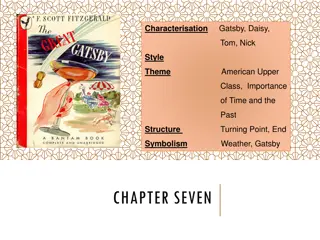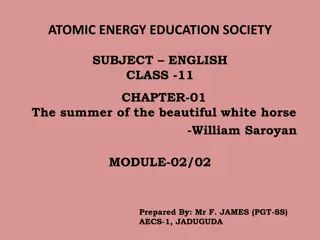Understanding Elastic Properties of Solids: Stress, Strain, and Modulus
Explore the concept of elasticity in solids through stress and strain analysis, defining elastic moduli such as Young's modulus, shear modulus, and bulk modulus. Discover how these properties describe the behavior of various materials under deformation. Quick quizzes demonstrate application scenarios, guiding understanding of material response to external forces.
Download Presentation

Please find below an Image/Link to download the presentation.
The content on the website is provided AS IS for your information and personal use only. It may not be sold, licensed, or shared on other websites without obtaining consent from the author. Download presentation by click this link. If you encounter any issues during the download, it is possible that the publisher has removed the file from their server.
E N D
Presentation Transcript
Phys 110 Chapter 12 Elasticity
LECTURE OUTLINE 12.4 Elastic Properties of Solids Stress Strain Elastic modulus Young s modulus Shear modulus Bulk modulus 2
We can describe the elastic properties of a substance using the concepts of stress and strain . . Stress is a quantity that is proportional to the force causing a deformation Stress is the external force acting on an object per unit cross-sectional area. The result of a stress is strain, which is a measure of the degree of deformation. Strain is proportional to stress; the constant of proportionality is called the elastic modulus. The elastic modulus is therefore defined as the ratio of the stress to the resulting strain: 3
We consider three types of deformation and define an elastic modulus for each:
Quick Quiz 12.4 A block of iron is sliding across a horizontal floor. The friction force between the block and the floor causes the block to deform. To describe the relationship between stress and strain for the block, you would use (a) Young s modulus (b) shear modulus (c) bulk modulus (d) none of these. Quick Quiz 12.5 A trapeze artist swings through a circular arc. At the bottom of the swing, the wires supporting the trapeze are longer than when the trapeze artist simply hangs from the trapeze, due to the increased tension in them. To describe the relationship between stress and strain for the wires, you would use (a) Young s modulus (b) shear modulus (c) bulk modulus (d) none of these. Quick Quiz 12.6 A spacecraft carries a steel sphere to a planet on which atmospheric pressure is much higher than on the Earth. The higher pressure causes the radius of the sphere to decrease. To describe the relationship between stress and strain for the sphere, you would use (a) Young s modulus (b) shear modulus (c) bulk modulus (d) none of these.
12.4 (b). The friction force on the block as it slides along the surface is parallel to the lower surface and will cause the block to undergo a shear deformation. 12.5 (a). The stretching of the wire due to the increased tension is described by Young s modulus. 12.6 (c). The pressure of the atmosphere results in a force of uniform magnitude perpendicular at all points on the surface of the sphere.
Example 12.6: As shown in figure below a cable used to support an actor as he swung onto the stage. Suppose that the tension in the cable is 940 N as the actor reaches the lowest point. What diameter should a 10-m-long steel wire have if we do not want it to stretch more than 0.5 cm under these conditions?
Problems 27. A 200-kg load is hung on a wire having a length of 4.00 m, cross-sectional area 0.200 x 104 m2, and Young s modulus 8.00 x 1010 N/m2. What is its increase in length?
31. A child slides across a floor in a pair of rubber-soled shoes. The friction force acting on each foot is 20.0 N. The footprint area of each shoe sole is 14.0 cm2, and the thickness of each sole is 5.00 mm. Find the horizontal distance by which the upper and lower surfaces of each sole are offset. The shear modulus of the rubber is 3.00 MN/m2.
35. When water freezes, it expands by about 9.00%. What pressure increase would occur inside your automobile engine block if the water in it froze? (The bulk modulus of ice is 2.00x109 N/m2.)
36. The deepest point in the ocean is in the Mariana Trench, about 11 km deep. The pressure at this depth is huge, about 1.13 x 108 N/m2. (a) Calculate the change in volume of 1.00 m3 of seawater carried from the surface to this deepest point in the Pacific ocean. (b) The density of seawater at the surface is 1.03 x 103 kg/m3. Find its density at the bottom.























